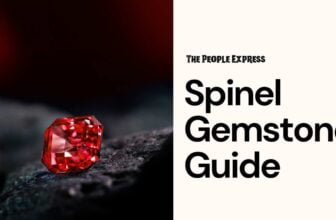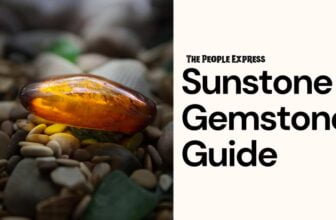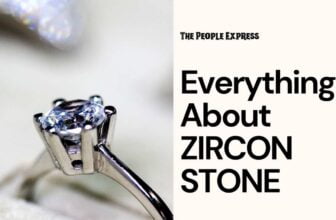Although purple has been a color used in jewellery since ancient times, there aren’t many purple gemstones. Compared to other colors such as blue, red and green that have hundreds of gemstone varieties to choose from, the number of purple gemstones is quite small. Purple Gemstones Guide Semi Precious Stones
Purple Gemstones Guide
Purple is often connected to royalty and nobility, power and wealth. It is a luxurious color and depicts prestige and class. Purple jewellery adds a touch of sophistication and elegance and is an eye-catching color.
There are many varieties of purple including violet, lilac, lavender, mauve, mulberry and wine. To help you choose your stone and shade, here are our top 12 purple gemstones for jewellery.
Purple Diamonds

Features:
- An exclusive gemstone
- Extremely rare
- Very expensive
- Synthetic and enhanced varieties available
Purple diamonds are created when there is a high amount of hydrogen present during the diamond’s formation. These spectacular stones are very rare and expensive, especially if the stone is vivid and saturated in color. However, enhanced or synthetic alternatives are relatively much more affordable.
Purple diamonds are known by a variety of nicknames, including Lilac, Orchid, Lavender, Grape and Plum Diamonds which describe the color of the stone. High quality purple diamonds are generally sought after by collectors and diamond enthusiasts or those with a penchant for exclusive jewellery.
Amethyst

Features:
- Most popular purple stone
- Abundantly found
- Affordable
- Good hardness
- Not very tough
Amethysts are the most well-known purple gemstone. In the past, amethysts were considered a cardinal gemstone (gemstones considered precious above all others) and on equal par with diamonds, sapphires, rubies and emeralds. However, when large deposits were found in Brazil, the value of amethysts dropped making it an affordable gemstone that suits almost all budgets.
Amethysts come in all shades of purple, with those displaying the deepest purple hues considered the best. Amethysts are durable enough for use in all types of jewellery (7 Mohs) but requires reasonable care to maintain its luster and color. They can easily get scratched and due to their brittleness, can chip or crack when exposed to rough wear. The color of amethysts can also fade if exposed to direct light for too long. However, if maintained well, amethyst jewellery can last a lifetime.
Purple Chalcedony

Features:
- Quite durable
- Vitreous – waxy luster
- Relatively affordable
Purple chalcedony comes in beautiful shades of purple from a light lilac to dark purple. Purple chalcedony is usually translucent to opaque, with a vitreous to waxy luster. It has a very appealing look with a rich natural color.
Chalcedony has a microcrystalline structure without crystal formations within it. As a result, it is compact, contains no cleavage and is very durable. Purple chalcedony is a tough stone with medium hardness (6.5 to 7 Mohs). Most chalcedony is cut en cabochon or used in beautiful carvings and engravings. However, sometimes these stones are faceted to add more depth and light play to the piece of jewellery. Chalcedony jewellery is ideal for bohemian and ethnic jewellery designs. learn more about Spinel Gemstone
Purple Spinel

Features:
- Very durable
- Somewhat rare
- Relatively affordable
- Very brilliant
Purple spinel comes in a variety of shades, with lilac and mauve considered more attractive. However, it is not as valuable or sought-after as red and blue spinel. Purple spinel is relatively affordable and a durable gemstone (Mohs 8) suited for every day wear.
It is a brilliant gemstone and due to this fact, is often cut into faceted gemstone shapes to enhance the brilliance. Purple spinel has been synthesized but it is rarely enhanced or treated, meaning that the color you see in a purple spinel stone is likely to be natural.
Iolite

Features:
- Popular
- Very abundant
- Not expensive
- Good brilliance
- Not highly durable
Although iolites are highly sought-after gemstones, they are quite stunning and can rival the beauty of more expensive blue stones such as sapphire or tanzanite. It is a highly brilliant stone that occurs in blue-purple shades, but due to its abundance, it is not highly valued.
Iolite has distinct cleavage making it susceptible to chipping or cracking if struck with force. However, it has fairly good hardness (7 to 7.5 Mohs) and can be used in almost all types of jewellery. When mounted in rings, it is best to set iolite in protective settings such as bezel or halo. Beautifully faceted iolite sparkles with eye-catching brilliance. Iolite is perfect for jewellery where it is able to catch light, such as on a ring or in dangling earrings.
Purple Jade

Features:
- Fair hardness
- Very tough
- Comes in two varieties
- Waxy luster
Most people think of green when they say the word jade, but jade occurs in a range of colors, including beautiful purple shades. There are two varieties of jade: nephrite and jadeite. Nephrite is more abundant and less expensive, while jadeite is considered of better quality and is pricier.
Purple jade is fairly soft (6 Mohs) but is very tough due to its compact composition. Purple jade is found in translucent to opaque varieties and has a smooth, waxy luster. Most jade is often cut into cabochons or various special smooth cuts or carved. Faceting jade is less common but can give the gemstone added depth.
Purple Sapphire

Features:
- Uncommon sapphire color
- Often untreated
- Excellent durability
- Quite rare
Say sapphire and we think of a vivid blue gemstone. But there is such a thing as purple sapphire which is rarer and as beautiful as its blue counterparts. This color occurs traces of elements such as chromium is present during the sapphire’s formation.
Many people sometimes confuse purple sapphires for amethysts, but purple sapphires are a more durable and harder (Mohs 9) gemstone, second only to diamonds but with better toughness. They are extremely resistant to breakage and chipping.
While most other sapphires on the market are heat treated to enhance color and clarity, purple sapphires are generally not treated because they have very good natural coloring. Because of their brilliance and durability, these sapphires are an excellent choice if you want a purple gemstone for an everyday piece of jewellery, such as an engagement ring.
Purple Fluorite

Features:
- Low durability
- Very rare
- Vitreous luster
- Often transparent
Fluorite is a very popular variety of gemstones among collectors but is not commonly used in jewellery due to its low durability. The quintessential fluorite color is purple, but it occurs in every color imaginable. While most purple fluorite occurs in a single color, there is a purple and white banded variety known as Blue John.
High quality purple fluorite should have very good transparency and be eye-clean. Fluorite has a beautiful vitreous luster and can be cut into most standard gemstone shapes. However, fluorite is very soft (Mohs 4) and has distinct cleavage. It is not suitable for most types of jewellery, especially those that are likely to have high exposure. However, it can be used in jewellery such as pendants and earrings.
Purple Kunzite

Features:
- Exhibits pleochroism
- Good clarity
- Light to vivid hues
- Affordable
- Distinct cleavage
Kunzite is little-known beautiful gemstone that occurs in pink to purple shades. The gem was first discovered in the USA but today most kunzite comes from Pakistan and Afghanistan. Most purple kunzite is quite light in color but some stones can have a vivid and intense hue.
Kunzite can also exhibit pleochroism, which refers to its ability to exhibit two colors at the same time depending on the angle it is viewed from. Typically, the two colors are pink and purple or colorless. Kunzite is also generally free of inclusions and has very good transparency. You can find kunzite in a range of fancy shapes, although smooth polished cabochons are also common.
Most kunzite on the market is free of treatments or enhancements. Kunzite is a fairly durable stone (6.5 to 7 Mohs) can be used for most types of jewellery. However, as it has very distinct cleavage, it is prone to breakage and needs to be protected from impact and blows. Kunzite remains a very affordable stone and because it is found in large sizes, it is perfect for large statement jewellery.
Purple Tourmaline

Features:
- Not a popular tourmaline color
- Very good durability
- Vitreous luster
- Brilliant
Purple tourmaline is not the most popular tourmaline color but is beautiful when set in jewellery. They come in a range of purple shades and can be quite affordable. All colored tourmaline exhibits some form of pleochroism. This makes tourmaline a dynamic and vibrant gemstone for jewellery, especially when viewed from different angles under lights.
Most purple tourmalines are faceted to enhance the stone’s brilliance and pleochroism (if noticeable). Purple tourmaline has good durability (7 to 7.5 Mohs) and with reasonable care can last a very long time. Heat treatment is commonly carried out on tourmalines to enhance their color; however, your vendor should let you know if such treatments have been done on your stone.
Sugilite

Features:
- Very rare
- Uncommon in jewellery
- Opaque to translucent clarity
- Contains patterns, patches and veins
- Medium durability
Sugilite was initially discovered in Japan and is categorized as a rare gemstone. Small deposits of sugilite have been found in other regions but these are not abundant. As a result, it is not a mainstream gemstone and there aren’t many options when it comes to sugilite jewellery.
Sugilite is found from faint pink-purple varieties to dark blue-purple. However, the most valuable and sought-after sugilite color is an evenly saturated vivid purple hue. Sugilite is often opaque to translucent and most contain dark veins or patches that form interesting patterns on its surface.
It is commonly cut en cabochon or carved into intricate and beautiful designs, although translucent sugilite can be faceted for added depth and light play. Sugilite is rarely enhanced or treated. It is not a very durable gemstone (5.5 to 6.5 Mohs) and can easily get damaged.
Purple Jasper

Features:
- Commonly found
- Opaque to translucent clarity
- Contains patterns, matrix and veins
- Medium hardness
- Very tough
Jasper is commonly red, but it can also be found in purple shades. It is a variety of chalcedony, a type of quartz. Jasper often has interesting matrix inclusions and patterns that add character to the stone and are quite desirable. Most jasper is translucent to opaque in clarity and is often cut en cabochon or carved. Jasper is rarely faceted.
With a hardness of 6.5 to 7 on the Mohs scale and very good toughness due to its compact nature, jasper jewellery can last a very long time without damage. As it is relatively affordable, it is an ideal gemstone for costume jewellery and statement pieces.
Some other purple gemstones
Here are some purple gemstones that we have not included in our list of top 12 purple gemstones.
- Charoite– This gemstone varies in color from lilac to deep purple. It is a somewhat soft, translucent gemstone that is found only in Siberia and is quite rare.
- Purple Agate – Agate can be found in all colors in banded and single color varieties. Gemstone Purple agate typically comes from Botswana and Brazil.
- Purple Lepidolite – This beautiful gemstone has a vitreous luster and is transparent to translucent in clarity. However it is very soft (2.5 to 33 Mohs) and not very suitable for jewellery.
- Purple Scapolite – Transparent with a vitreous luster, scapolite is a sparkly gemstone with medium hardness. It is quite a rare gemstone and is sought-after by collector’s and mineral enthusiasts.
Purple Gemstones and Metals
Purple gemstones go well with all metal colors, which is a factor that determines the style of the jewellery. For example, white metals such as platinum, silver or white gold give a contemporary look to purple gemstones, making them stand out in contrast. An amethyst in a white gold setting, for example, appears prominent and to full advantage.
Rose and yellow gold settings offer a unique, vintage look when combined with purple gemstones. These are more classical in appearance and are not very commonly chosen combinations.
Symbolism of Purple in Jewellery
Purple is a combination of red and blue, which are the warmest and coolest colors. As such, it combines the fierce energy of red with the calming, soothing vibes of blue for a balancing, harmonious feel.
Purple has been connected to royalty and the upper echelons since ancient times, with history stating that Queen Elizabeth the First only allowing members of the royal family to wear it. It is also a rare color in nature, giving purple gemstones that extra allure.
Where to Shop
Because purple is a relatively popular gemstone color, you will have options even at a brick and mortar store. Most physical stores commonly stock amethysts, although other purple gemstones may be uncommon. However, if you take your search online, even the harder to find purple gemstones will be accessible.
Conclusion
When shopping for gemstones, always purchase from a reputable and licensed jeweller and check the origin of the stone. Ask about what treatments have been conducted on the stone and where applicable, request a certificate of authenticity. Always take some time to check the genuineness and value of the item, especially if the gemstone you are eyeing is expensive.
Table of Contents
Toggle





